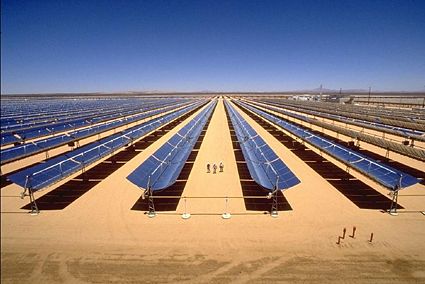Solar could meet California energy demand three to five times over
March 17, 2015

Parabolic trough mirrors used for steam generation in concentrated solar power plants (credit: NOAA)
Carnegie Science researchers have found that the amount of energy that could be generated from solar equipment constructed on and around existing infrastructure in California would exceed the state’s demand by up to five times.
“Integrating solar facilities into the urban and suburban environment causes the least amount of land-cover change and the lowest environmental impact,” according to Carnegie’s Rebecca R. Hernandez (now at University of California Berkley).
The team found that just over 8 percent of all of the terrestrial surfaces in California have been developed by humans, from cities and buildings to park spaces. Residential and commercial rooftops present plenty of opportunity for power generation through small- and utility-scale solar power installations, the team said. Other compatible opportunities are available in open urban spaces such as parks.
California has about 6.7 million acres (27, 286 square kilometers) of land that is compatible for photovoltaic solar construction and about 1.6 million acres (6,274 square kilometers) compatible for concentrating solar power. There is also an additional 13.8 million acres (55,733 square kilometers) that is potentially compatible for photovoltaic solar energy development with minimal environmental impact and 6.7 million acres (27,215 square kilometers) also potentially compatible for concentrating solar power development.
“Because of the value of locating solar power-generating operations near roads and existing transmission lines, our tool identifies potentially compatible sites that are not remote, showing that installations do not necessarily have to be located in deserts,” Hernandez said.
This study, published by Nature Climate Change, included two kinds of solar technologies: photovoltaics, which use semiconductors and are similar to the solar panels found in consumer electronics, and concentrating solar power, which uses enormous curved mirrors to focus the sun’s rays.
A mix of both options would be possible, the researchers suggest. They found that small- and utility-scale solar power could generate up to 15,000 terawatt-hours of energy per year using photovoltaic technology and 6,000 terawatt-hours of energy per year using concentrating solar power technology.
“As California works to meet requirements that 33 percent of retail electricity be provided by renewable sources by 2020 and that greenhouse-gas emissions be 80 percent below 1990 levels by 2050, our research can help policymakers, developers, and energy stakeholders make informed decisions,” said Chris Field, director of Carnegie’s Department of Global Ecology. “Furthermore, our findings have implications for other states and countries with similarly precious environmental resources and infrastructural constraints.”
Abstract of Efficient use of land to meet sustainable energy needs
The deployment of renewable energy systems, such as solar energy, to achieve universal access to electricity, heat and transportation, and to mitigate climate change is arguably the most exigent challenge facing humans today. However, the goal of rapidly developing solar energy systems is complicated by land and environmental constraints, increasing uncertainty about the future of the global energy landscape. Here, we test the hypothesis that land, energy and environmental compatibility can be achieved with small- and utility-scale solar energy within existing developed areas in the state of California (USA), a global solar energy hotspot. We found that the quantity of accessible energy potentially produced from photovoltaic (PV) and concentrating solar power (CSP) within the built environment (‘compatible’) exceeds current statewide demand. We identify additional sites beyond the built environment (‘potentially compatible’) that further augment this potential. Areas for small- and utility-scale solar energy development within the built environment comprise 11,000–15,000 and 6,000 TWh yr−1 of PV and CSP generation-based potential, respectively, and could meet the state of California’s energy consumptive demand three to five times over. Solar energy within the built environment may be an overlooked opportunity for meeting sustainable energy needs in places with land and environmental constraints.